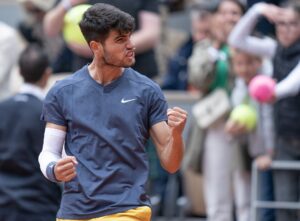World #2 Rafael Nadal will meet world #4 Roger Federer in arguably the most hotly anticipated clash of the Indian Wells Masters. Both the Spaniard and the Swiss arrived in the Californian desert in good form and both will be hoping to book their place in Sunday’s final, where they will face either Austria’s Dominic Thiem or Milos Raonic of Canada. But what is the history behind this most illustrious of rivalries?
A rivalry for the ages
This will be the 39th meeting between Nadal and Federer in a head-to-head the Spaniard leads 23-15. It was Nadal who won their first meeting, upsetting Federer in the third round in Miami in 2004, 6-3 6-3. Federer avenged that defeat a year later, beating Nadal 2-6 6-7 7-6 6-3 in the final in Key Biscayne. However, Nadal followed that with five straight wins, including four finals in a row, before Federer snapped the Spaniard’s winning streak with a 6-0 7-6 6-7 6-3 win in the Wimbledon final in 2006.
But in spite of the occasional Federer victory, Nadal seized control of their rivalry, crushing Federer in the 2008 Roland Garros final before beating him in a five-set thriller at Wimbledon to complete the Channel Slam. He then won a third straight Grand Slam final against Federer at Melbourne Park early in 2009, before Federer scored a rare win on clay in the 2009 Madrid Open final. However, Nadal continued to dominate their rivalry through the early years of this decade, despite some Federer victories, including in Indian Wells in 2012.
However, in 2017, Federer faced Nadal again in the Australian Open final after nearly six months away from the tour through injury. Few would have backed the Swiss going into the match, but he pulled off a superb 6-4 3-6 6-1 3-6 6-3 victory over Nadal. He followed that with three more victories, beating Nadal in Indian Wells in the last eight, and in finals at the Miami Open and the Shanghai Masters, winning all three matches in straight-sets.
Path to the semifinals
Nadal began his Indian Wells campaign, after a first-round bye, against Jared Donaldson of the USA. Nadal swept the young American aside, 6-1 6-1, to set up a third-round clash with Diego Schwartzman. The Argentine was also able to offer little resistance as Nadal scored a comprehensive 6-3 6-1 win. Nadal backed that up with a 6-3 6-4 win over Serbia’s Filip Krajinovic, before he overcame the challenge of 12th seed Karen Khachanov 7-6 7-6 to reach the last four. However, he looked to be struggling with a knee injury against the Russian, which may jeopardise his semifinal chances.
Federer, who also received a first-round bye, opened his tournament with a 6-1 7-5 win over Germany’s Peter Gojowczyk. Federer then beat his countryman Stan Wawrinka 6-3 6-4 in under an hour to reach the last 16. There he proved far too strong for Britain’s Kyle Edmund, brushing aside the Yorkshireman’s challenge with a 6-1 6-4 win. He then accounted for the in-form Hubert Hurkacz, defeating the Pole 6-4 6-4 to book his place in the semifinals.
How do they match up?
Any clash between Nadal and Federer pits two of the greatest tennis players of all time against one another. That typically leads to a high-quality encounter, featuring plenty of jaw-dropping shots and thrilling rallies. Nadal’s best shot is his forehand, with the vicious combination of pace and spin he imparts particularly effective on the gritty hard courts in Indian Wells. However, he can also do damage with his backhand, whilst he has worked hard to improve his serve during the off-season, with impressive results. But if the knee injury he picked up against Khachanov proves to be severe and his movement is limited, it will be difficult indeed for the Spaniard to find a path to victory in this match.
However, despite the work Nadal has done to increase the versatility and power of his serve, it is no match for Federer’s. There are none more accurate from the line than the great Swiss, whose serve is the bed rock of his game. However, his forehand is also a useful shot, whilst his backhand, once exploited by Nadal with signal success, has improved dramatically since he switched to a larger racquet face. That change has cost him some of the bite on his backhand slice. However, he remains amongst the most accomplished volleyers on the ATP Tour.
Main photo:
Embed from Getty Images






